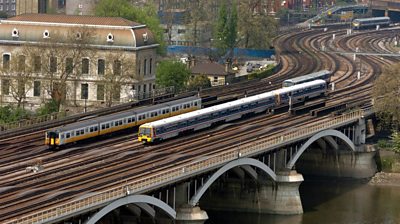What Can Go Wrong?
- Someone could get hit by a moving train/tram/tube.
- Someone could receive an electric shock from the third rail or overhead lines.
- Someone could fall from the platform.
- Someone could slip or trip at the location.
Legal/�������� Requirements
- Obtain permission from the relevant rail authority/operator, train operating company and station manager prior to any activity occurring on railway property including taking photographs, and allow adequate time for permissions to be given.
- Attend any induction and training required by the railway company and follow any instructions given.
Control Measures
General Controls
- Find out about local risks and emergency procedures and communicate them to the rest of the team.
- Request a copy of the relevant railway authorities risk assessment detailing working practices. It is likely you will also need to provide your risk assessment to them.
- Don’t allow any equipment to come near to or in contact with any live rail or overhead power lines.
- Don’t operate broadcast equipment out of a train window unless you have the approval of the rail and train operating company Ensure suitable communications are in place that will work at the location (e.g. in a tunnel or at an underground tube station) and speak to the railway authority to ensure the correct equipment is used.
- Don’t allow our lights or activities distract the driver.
- Stay clear of the platform edge and stay behind the yellow lines where they are provided.
- Wear sensible footwear and if required by the rail company, personal protective equipment (e.g. orange high visibility jacket) Orange high visibility jackets and other PPE are available from the safety equipment stores.
- Where possible recording area to be cordoned off.
- Manage all cables safely and don’t block any walkways or signalling with our equipment/people.
- Consider using wireless equipment to eliminate trailing wiring.
- Consider using a lookout (though not the supervisor) when working on or near an operational rail track.
- If requested by rail company complete a 1 day personal track safety (PTS) course if you are going trackside.
- Maintain safe distance from track – minimum 1.4m, more for higher speed lines.
- If shooting with a moving train ensure approvals have been agreed ahead of time and the sole use of track and train is agreed.
Recommended links
More from SSR
- Your platform to record accidents, risk assessments, assurance monitoring and inspections
- Safety Equipment StoresJust one number to call: 0844 800 8875
- �������� Safety GuidelinesAn A-Z of ��������'s Health and Safety Guidelines
- Safety Advice Line: 0370 411 0464 Email: safety@bbc.co.uk
Events guidance - key links:
- Exhibitions
- General Guidance
- Indoor Location Recce Checklist
- Outdoor Location Recce Checklist
- Major Incidents & Emergency Planning
- Marketing and Promotional
- Noise Exposure
- Planning and Management
- Responsibilities
- Responsibilities Form
- Laser Lighting Effects
- Strobe Lighting
- Temporary Stages and Rostra
Health topics - key links:
- (�������� network only)
- Contributors Fitness to Participate
- Display Screen Equipment (DSE)
- (�������� network only)
- First Aid and Welfare on Location
- International Travel - Risks & Health
- Manual Handling
- Mental Health: ��������page
- (�������� network only)
- Personal Health and Wellbeing
- Pregnancy
- Psychological Trauma Support & Trauma Risk Management (TRiM)
- Tiredness and Fatigue
- Travel Health Contacts
�������� High Risk - key links:
- CBRN and Industrial Spills
- Covert Filming
- Crisis Management and Security Support
- Demonstrations, Protests and Crowds
- Disaster Coverage
- Door Stepping
- (�������� network only)
- (�������� network only)
- Public Order
- Safety Equipment Stores
�������� Journalism - key links:
�������� Productions - key links:
- Aerial Filming and Airfields
- Animals: Displaying and handling for performance
- Boats: Working on
- Children and Young People
- Driving
- Electrical Equipment and Systems
- First Aid and Welfare on Location
- Food Safety (Cooking and Catering)
- Remote Location Working
- Roads and Streets: Working by
- Security of Productions on Location
- Stunts
- Tiredness and Fatigue
- Unmanned Aerial Systems (UAS aka Drones)
- Vehicles: Recording in, from and around
- Working at Height: Mobile Elevating Work Platforms
- Working at Height: Tower Scaffolds
- (�������� Network only)
�������� Security - key links:
�������� Sport - key links:
About this site
This site describes what the �������� does in relation to managing its health, safety and security risks and is intended for those who work directly for the ��������.
It is not intended to provide instruction or guidance on how third parties should manage their risks. The �������� cannot be held liable for how this information is interpreted or used by third parties, nor provide any assurance that adopting it would provide any measure of legal compliance. More information
Some links on this site are only accessible when connected to the �������� network
